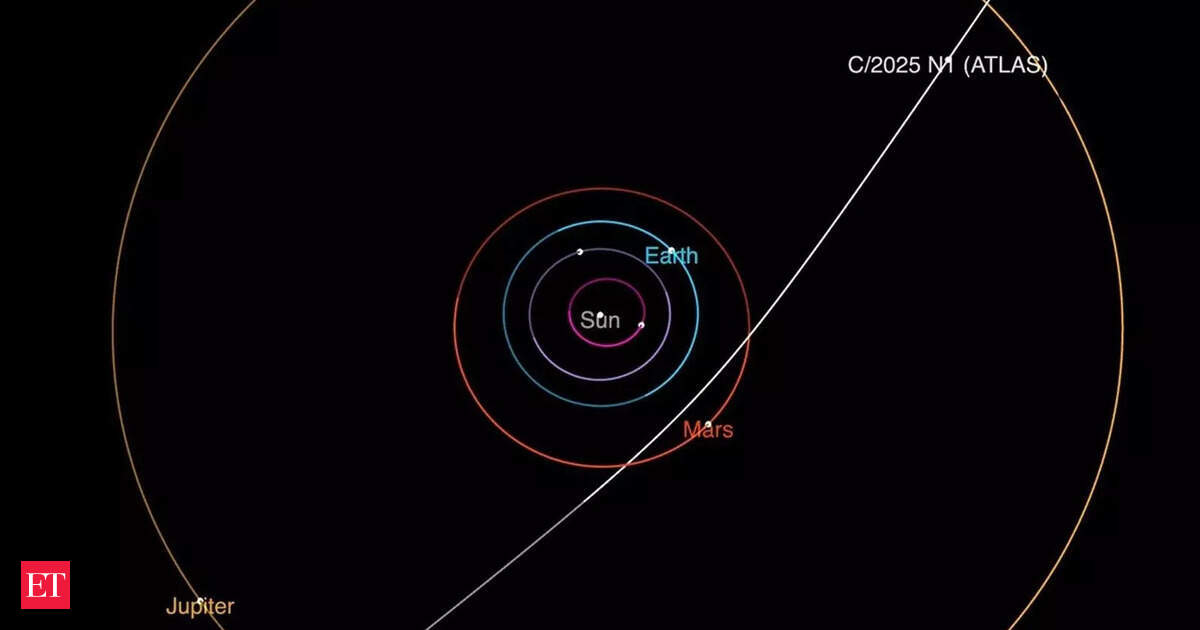“On July 1, the NASA-funded ATLAS (Asteroid Terrestrial-impact Last Alert System) survey telescope in Rio Hurtado, Chile, first reported observations of a comet that originated from interstellar space. Arriving from the direction of the constellation Sagittarius, the interstellar comet has been officially named 3I/ATLAS. It is currently located about 420 million miles (670 million kilometers) away,” said NASA in a press statement.
Since that first report, observations from before the discovery have been gathered from the archives of three different ATLAS telescopes around the world and the Zwicky Transient Facility at the Palomar Observatory in San Diego County, California. These “pre-discovery” observations extend back to June 14. Numerous telescopes have reported additional observations since the object was first reported.
The newest visitor is 416 million miles (670 million kilometers) from the sun, out near Jupiter, and heading this way at a blistering 37 miles (59 kilometers) per second. After converting, 59 km/s translates into 212,400 km/h.
What are key features of the comet?
The comet poses no threat to Earth and will remain at a distance of at least 1.6 astronomical units (about 150 million miles or 240 million km). It is currently about 4.5 au (about 416 million miles or 670 million km) from the Sun. 3I/ATLAS will reach its closest approach to the Sun around Oct. 30, at a distance of 1.4 au (about 130 million miles or 210 million km) — just inside the orbit of Mars.
The interstellar comet’s size and physical properties are being investigated by astronomers around the world. 3I/ATLAS should remain visible to ground-based telescopes through September, after which it will pass too close to the Sun to observe. It is expected to reappear on the other side of the Sun by early December, allowing for renewed observations.NASA said the comet will make its closest approach to the sun in late October, scooting between the orbits of Mars and Earth — but closer to the red planet than us at a safe 150 million miles (240 million kilometers) away.When can we spot it?
The comet should be visible by telescopes through September, before it gets too close to the sun, and reappear in December on the other side of the sun.
Based on its brightness, the comet appears to be bigger than the first two interstellar interlopers, possibly several miles (tens of kilometers) across, Chodas said. It’s coming in faster, too, from a different direction, and while its home star is unknown, scientists suspect it was closer to the center of our Milky Way galaxy.
The first interstellar visitor observed from Earth was Oumuamua, Hawaiian for scout, in honor of the observatory in Hawaii that discovered it in 2017. Classified at first as an asteroid, the elongated Oumuamua has since showed signs of being a comet.
The second object confirmed to have strayed from another star system into our own — 21/Borisov — was discovered in 2019 by a Crimean amateur astronomer with that name. It, too, is believed to be a comet.
“We’ve been expecting to see interstellar objects for decades, frankly, and finally we’re seeing them,” Chodas said. “A visitor from another solar system, even though it’s natural — it’s not artificial, don’t get excited because some people do … It’s just very exciting.”

